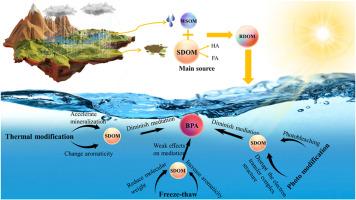Sources of dissolved organic matter in initial rainwater and its photochemical activity
IF 8.7
Q1 Environmental Science
引用次数: 0
Abstract
The dissolved organic matter in initial rainwater (RDOM), including soil-dissolved organic matter (SDOM) and water-soluble organic matter (WSOM) in the atmosphere, can potentially mediate the migration and transformation of contaminants in natural water. However, researches on its sources, characteristics, and impact of environmental factors are limited. This study aims to investigate the main sources of RDOM and its properties influenced by environmental factors (such as light exposure and temperature variation). The results revealed that RDOM was mainly composed of SDOM. Temperature (–5°C, −20°C, temperature alternating, 40°C, 50°C, 60°C) induced the variation of SDOM components, altering its fluorescence characteristics, aromatic components, and hydrophobicity. And high temperature showed a more pronounced effect on SDOM components. However, temperature fluctuations had different impacts on the SDOM-mediated photodegradation of bisphenol A (BPA). Among them, only SDOM that had undergone freeze-thaw cycles exhibited a promotive effect on the photodegradation of BPA, with the most significant effect observed at −20°C. Illumination (ultraviolet light (UV) and natural light (NL)) consumed the chromophoric groups of SDOM, disrupted its intricate electron transfer structure, and reduced the production of •OH and Triplet-state dissolved organic matter (3DOM∗). So, illumination, especially UV, significantly weakened its mediating effect on the photodegradation of BPA. Based on these findings above, RDOM through temperature increase and illumination potentially leads to an inhibition of the degradation rate of organic pollutants. Conversely, RDOM may exhibit an enhanced ability following a freeze-thaw process. This study is crucial for elucidating the environmental effects of RDOM.

初始雨水中溶解有机物的来源及其光化学活性
初始雨水中溶解有机质(RDOM),包括土壤溶解有机质(SDOM)和大气中水溶性有机质(WSOM),可以潜在地介导自然水体中污染物的迁移和转化。然而,对其来源、特征和环境因素影响的研究较少。本研究旨在探讨RDOM的主要来源及其受环境因素(如光照和温度变化)影响的特性。结果表明,RDOM主要由SDOM组成。温度(-5°C, - 20°C,温度交替,40°C, 50°C, 60°C)引起SDOM成分的变化,改变其荧光特性,芳香成分和疏水性。高温对SDOM组分的影响更为明显。然而,温度波动对sdom介导的双酚A (BPA)光降解有不同的影响。其中,只有经过冻融循环的SDOM对BPA的光降解有促进作用,且在−20℃时效果最为显著。光照(紫外光(UV)和自然光(NL))消耗了SDOM的显色基团,破坏了其复杂的电子转移结构,减少了•OH和三态溶解有机物(3DOM *)的产生。因此,光照,尤其是紫外线,显著削弱了其对BPA光降解的中介作用。综上所述,通过温度升高和光照,RDOM可能会抑制有机污染物的降解速度。相反,RDOM可能在冻融过程中表现出增强的能力。本研究对阐明RDOM对环境的影响具有重要意义。
本文章由计算机程序翻译,如有差异,请以英文原文为准。
求助全文
约1分钟内获得全文
求助全文
来源期刊

Water Cycle
Engineering-Engineering (miscellaneous)
CiteScore
9.20
自引率
0.00%
发文量
20
审稿时长
45 days
 求助内容:
求助内容: 应助结果提醒方式:
应助结果提醒方式:


